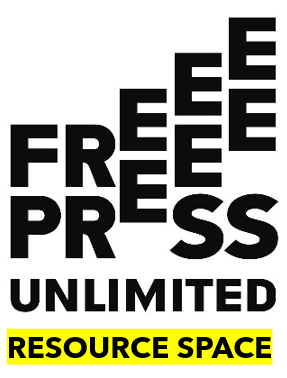Increasing the skills and leadership of women journalists is essential to increase the participation of women in the media sector. There are many sources and approaches to support women in journalism, which are detailed on this page.
- Training and mentoring programmes
- Networks for women
- Promoting the work of women journalists
- Leadership
- Tools and resources
Resources for women journalists
The Global Investigative Journalism Network compiled an overview of key resources for women journalists, including grants, networks, mentoring opportunities and safety guides.
Resources for journalists of color
Lam Thuy Vo, Disha Raychaudhuri and Moiz Syed developed a Resource Guide for Journalists of Color.
Training and mentoring
Training and mentoring women journalists helps to build their skills and gain better positions in the media sector. Below you can find a number of examples of mentoring and training programmes realised in cooperation with Free Press Unlimited.
Community radio fellowships
In Bangladesh and Indonesia, Free Press Unlimited contributed to successful fellowship programmes for young, marginalised women to train as professional community media journalists. After orientation, the fellows pursued a mentoring programme at a community radio station. Fellows produced stories about topics that mattered to them, such as child marriage, living standards, education, female leaders and role models.
The fellowship programmes contributed to empowerment, employability and recognition of the fellows. The participating radio stations were also able to broadcast an increased number of women’s voices and stories.
The Bangladesh fellowship program was a World Summit on the Information Society (WSIS) 2016 Prize Winner. The fellows also received UNFPA and UNICEF Meena Media awards at the national level.
Learn more
Learn more about the fellowship programme in Bangladesh and Indonesia.
Women photographers
In Iraq a training programme for women photographers was organised to promote gender equality in the male-dominated profession, and boost the variety of images of women shown in the media. After the initial training, photographers had a month to work on their stories. They were supported by Metrography, Iraq’s first and only photo agency, in editing their projects. The stories covered topics like women’s rights, freedom of speech, violence against women, women’s empowerment and climate change. An exhibition of the photo stories traveled through Iraq and several of the trainees gained work as freelancers with Metrography.
Networks of women journalists
Networks form an important way for women journalists to connect to each other and exchange experiences. In a male-dominated industry, it can be very useful to have this kind of network for peer support, collaboration and mentorship.
Internationally, examples of networks include the International Association of Women in Radio & Television and the International Women’s Media Foundation. A full overview of international and regional networks can be found in the GIJN Guide: Resources for Women Journalists.
Conferences and events are also a useful way for women journalists to meet each other. For example, African Women in the Media has a very active Facebook group to connect women online, and also hosts an annual conference.
Promoting the work of women journalists
Interruptrr Africa is a monthly newsletter that provides a roundup of the main headline news from Africa by women journalists. Supported by the European Journalism Centre, it highlights women’s expertise on Africa and African issues. It was inspired by Foreign Policy Interrupted, which promotes the work of women journalists and highlights their perspective on foreign policy news.
Leadership
Worldwide, women are underrepresented in leadership positions in the media sector. A study by IWMF shows that women hold just over a quarter (27%) of top management positions. Similarly, an analysis by the Reuters Institute for the Study of Journalism found that only 23% of the top editors across 200 major outlets analysed sample were women, despite the fact that, on average, 40% of journalists in the markets analysed were women.
This means that most decisions and policies within media organisations are made by men. Increasing the number of women in leadership positions creates more gender equality in the sector, and provides role models for young women.
The media is a male business
Statistics compiled by Nordicom show that the leadership of the 100 largest international media corporations is dominated by men, February 26, 2018.
According to research by the International Labour Organisation (ILO), the most significant obstacles to women’s leadership include the lack of role models for women and socio-cultural barriers related to gender stereotypes and expectations.
With regards to journalism organisations, WAN INFRA argues that the following factors inhibit progress towards gender diversity: social forces, cultural norms, family obligations, unequal pay, limited self-advocacy, and women only covering ‘women’s news’.
Online course
The AGEMI platform has a learning unit on Women and leadership in media industries.
Women Leadership Programme
In Nigeria the Wole Soyinka Centre for Investigative Journalism (WSCIJ) runs a Female Reporters Leadership Programme.
Over the course of six months, women journalists receive training and mentoring. The fellows are expected to develop both their leadership skills and reporting skills. Since the start of the project three years ago, WSCIJ has trained 134 reporters across the country, produced 53 leadership projects, and enabled the production of 65 girl and women-focused stories.
Among the women who followed the fellowship and took the evaluation survey, 59% were promoted or given greater responsibilities in their organisations afterwards.

Tools and Resources
- The Global Investigative Journalism Network compiled an overview of key resources for women journalists, including grants, networks, mentoring opportunities and safety guides.
- The report ‘Getting the Balance Right: Gender Equality in Journalism’ by IFJ and UNESCO provides practical suggestions to improve the position of women journalists
- Leading to Choices: A Leadership Training Handbook for Women by Mahnaz Afkhami, Ann Eisenberg and Haleh Vaziri
- The AGEMI platform has a learning unit on Women and leadership in media industries.
